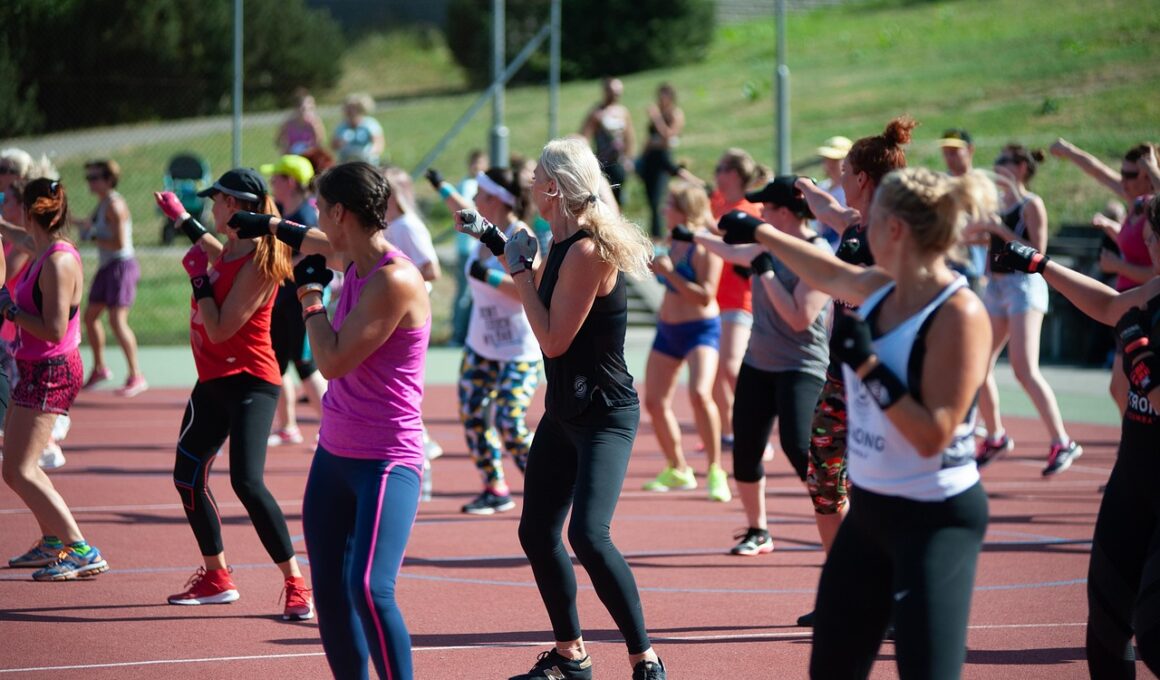Dance Fitness as a Social Intervention for Youth Engagement
Dance fitness programs have emerged as a dynamic approach to engage youth, promoting not only physical health but also social connectivity. This is crucial in today’s fast-paced world, where many young individuals struggle with feelings of isolation and disconnection. By incorporating dance into fitness routines, these programs bolster community ties and foster friendships among participants. As youth gather to learn and practice various dance moves, they cultivate relationships that extend beyond the studio. Dance fitness activities provide a platform for self-expression, creativity, and collaboration, allowing young people to express their identities in a safe environment. The combination of physical movement and communal interaction leads to improved mental health outcomes, reduced anxiety, and heightened self-esteem. Furthermore, the inclusive nature of these programs enables individuals from diverse backgrounds to come together. By engaging in dance fitness, youth can share experiences that transcend cultural and socioeconomic barriers. Consequently, these programs are crucial to building understanding and acceptance among different groups. Dance fitness not only promotes individual growth but also nurtures a collective ethos among youth, paving the way for more vibrant, interconnected communities.
The role of leadership within dance fitness programs significantly influences youth engagement and retention rates. Effective instructors can create an inspiring environment, encouraging youth to explore their potential in a welcoming manner. This is essential for creating a space where participants feel comfortable expressing themselves and developing their skills. Additionally, the selection of music and dance styles can play a crucial role in maintaining enthusiasm and motivating participants. Modern trends in music can capture the interest of younger participants, making routines both accessible and exciting. Regular feedback and support from instructors provide a sense of belonging for each participant, fostering a community where shared challenges and successes can be celebrated. Leadership extends beyond teaching choreography — it encompasses mentorship and active listening, addressing the individual needs of participants. The impact of strong leadership is evident in increased motivation, where participants are eager to attend classes regularly. Commitment to fitness and social engagements grows as youth develop a supportive peer network. In this context, dance fitness becomes more than just movement; it evolves into a comprehensive support system, bridging gaps between self-improvement, wellness, and social interaction.
Benefits of Dance Fitness for Youth
The benefits of dance fitness extend well beyond physical exercise, encompassing mental and emotional well-being. Engaging in dance activates various body functions, promoting physical health through improved cardiovascular fitness, flexibility, and strength. Yet, equally important are the psychological benefits that arise from regular participation in these programs. For many youth, dance provides an effective outlet for stress relief and emotional regulation. As participants immerse themselves in movement, they release endorphins, resulting in improved mood and reduced feelings of anxiety and depression. The sense of achievement gained from mastering new dance skills further elevates self-esteem. Social interactions fostered within dance fitness classes cultivate supportive friendships, crucial for adolescents as they navigate the challenges of growing up. Importantly, the practice of working together encourages teamwork, communication, and conflict resolution skills, key components for personal development. By building relationships grounded in shared experiences, youth learn the value of collaboration and support. This nurturing environment influences their sense of belonging, contributing positively to their social identity during formative years, thus reinforcing the importance of dance fitness as a holistic intervention.
Community involvement is another significant outcome associated with youth participation in dance fitness programs. When young people engage collectively, not only do they foster friendships, but they also cultivate a sense of duty towards their community. Many programs encourage youth to participate in local events or outreach initiatives, demonstrating the impact of dance fitness on broader societal engagement. Activities such as performances, fundraisers, or dance-offs allow participants to showcase skills while supporting causes they believe in. Through these opportunities, youth develop a deeper understanding of social responsibility and the importance of giving back. Moreover, a supportive environment helps to foster leadership skills as participants often take on roles that encourage organizational abilities and public speaking. This involvement contributes to personal growth, as youth learn to articulate their thoughts and engage with diverse audiences effectively. Additionally, dance fitness programs can attract public and private sponsorships, further enhancing their ability to serve local communities. With active community participation in local dance fitness events, programs can continue to thrive. This cycle ensures lasting connections between participants, enhancing overall youth engagement within communities.
Overcoming Barriers to Participation
While the benefits of dance fitness programs for youth are immense, several barriers can hinder participation. Young people may face challenges related to accessibility, affordability, or lack of awareness about available programs. These obstacles can be particularly pronounced in underserved communities, where resources may be limited. To address these challenges, proactive measures can create equitable opportunities for youth engagement. Organizations can seek funding and partnerships to make classes more affordable or free for participants. Outreach initiatives that include information sessions in schools and community centers can help raise awareness about dance fitness benefits. By utilizing social media and local influencers, programs can reach broader youth audiences, showcasing firsthand experiences. Additionally, incorporating various dance styles and formats, like hip-hop, salsa, or Zumba, can appeal to diverse interests, attracting a wider range of participants. Encouraging parental involvement can also enhance participation rates, creating an environment where families recognize the value and benefits of dance fitness for their children. Overall, addressing these barriers ensures inclusivity, ensuring all youth can be part of dance fitness programs and benefit from the transformative effects.
The long-term implications of dance fitness as a social intervention extend beyond immediate benefits, fostering resilience and integrity among participants. As youth engage in these programs, they instill qualities such as discipline, commitment, and teamwork, all crucial for navigating future challenges. The consistency required in dance training correlates with improved time management and personal accountability, skills that prove beneficial in various life domains. Furthermore, the friendships and networks created through dance classes often persist beyond the program, establishing lifelong connections. This can enhance social capital, as peers support each other in future endeavors, be it academic or career-related. The essence of community developed through dance fitness also encourages ongoing engagement with local events, ensuring participants remain connected and active citizens. Developing strong communication and interpersonal skills boosts confidence levels, which can influence career opportunities in the future. Ultimately, the skills and connections forged within these programs prepare youth for a bright future, creating a ripple effect that extends to families and communities as engaged, committed individuals contribute positively to society. Thus, dance fitness serves as an investment in youth capable of transforming lives.
Conclusion
In conclusion, dance fitness programs uniquely position themselves as powerful vehicles for youth engagement, fostering both physical and social development simultaneously. As highlighted throughout this article, the benefits extend far beyond fitness, addressing important elements of mental well-being and social connectivity. With strong leadership, community involvement, and proactive approaches to overcoming barriers to participation, these programs can thrive. Furthermore, the long-term implications provide participants with essential life skills that cultivate resilience, cooperation, and self-esteem. By investing in dance fitness initiatives, communities effectively contribute to a holistic approach in youth development, addressing both individual and societal needs. Ultimately, fostering such environments ensures that young individuals can thrive in myriad aspects of their lives, leading to stronger, more meaningful connections. The holistic nature of these programs encourages youth to express themselves in creative ways, building self-confidence while nurturing relationships that enhance their overall quality of life. Moving forward, continued support and awareness for dance fitness as a social intervention will be critical in empowering youth and shaping healthier futures.
In summary, the concept of dance fitness transcends mere physical activity, embedding itself as a crucial component of social intervention for youth. By engaging in diverse dance forms, young people stimulate both their bodies and minds, promoting a well-rounded approach to personal development. This unique method of collective engagement cultivates a powerful sense of belonging among participants, essential for mental health. Communities benefit significantly when youth are given healthy outlets to express themselves, emphasizing the need for support and resources for such programs. As we understand the importance of these initiatives, it is vital to advocate for the expansion and funding of dance fitness programs. Collective efforts can ensure that available offerings remain accessible, inclusive, and relevant to various cultural backgrounds. Through strategic planning and community involvement, dance fitness can become a pivotal movement towards empowering youth to lead productive, fulfilling lives. The long-term outcomes demonstrate that when youth have a positive space for expression, they not only grow themselves but also influence their peers positively. Thus, embracing dance fitness as a vital social intervention is a necessary step towards nurturing engaged and resilient generations.


